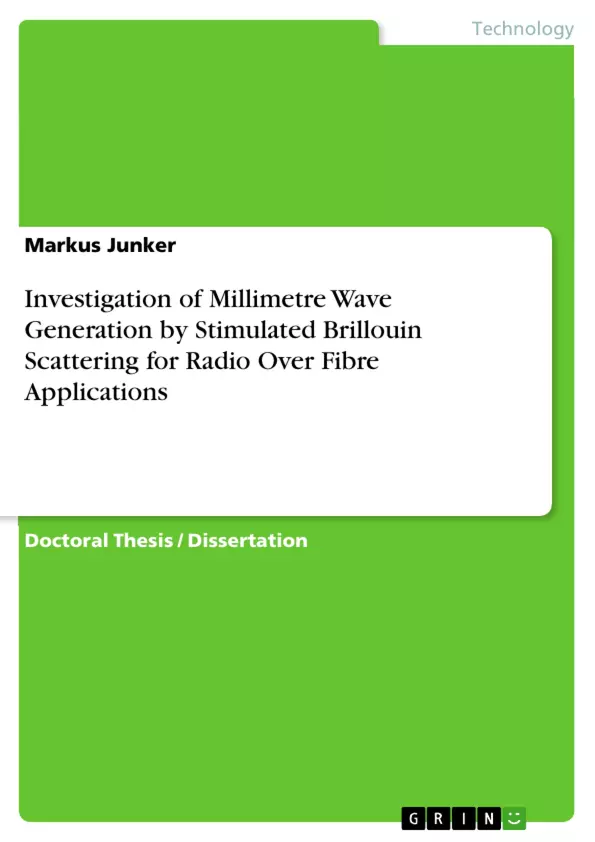The rising demand for greater bandwidth and increased flexibility in modern telecommunication systems has lead to increased research activities in the field of Millimetre Wave-Photonics. The combination of an optical access network and the radio propagation of high data-rate signals provides a solution to meet these demands. Such structures are also known as Radio Over Fibre systems. They implement the optical Millimetre Wave generation in a central station and the transmission of radio waves via a remote antenna unit to the radio cell. The expected data rate is very high, due to the fact that both the optical and the radio-link provide a large transmission bandwidth. This dissertation concerns the investigation of a new and simple method for the flexible generation of Millimetre Waves for application in Radio Over Fibre systems. The method is based on the heterodyne detection of two optical waves in a photo detector. By externally amplitude modulating the optical wave, different sidebands are generated. Two of these sidebands are selected and amplified by the non-linear effect of stimulated Brillouin scattering. As a gain medium, a standard single mode fibre is used. According to the theoretical investigation, very good carrier performances are possible with this method, and a computer simulation shows little degradation to the signals during their propagation in the system. The measured results are in strong agreement with the theoretical analysis. Experimental results show that the system can be fully utilised as a Radio Over Fibre system. The thesis is divided into five main parts: Introduction – Theory – Simulation – Experiment – Conclusion. In the Introduction, an overview of the current methods of Millimetre Wave generation, Radio Over Fibre and the nonlinear effect of Brillouin scattering is given. In the theoretical section, a differential equation system which mathematically describes the system is derived and also solved numerically. With a proof of the concept set-up, the simulated results are compared with the experimental data. In the last section the work is concluded and future tasks are discussed.
Inhaltsverzeichnis (Table of Contents)
- Abstract
- Declaration
- Acknowledgements
- List of Abbreviations
- Introduction
- 1.1 Millimetre Wave Generation
- 1.2 Radio Over Fibre
- 1.3 Stimulated Brillouin Scattering
- Theory
- 2.1 The Generation of Millimetre Waves
- 2.1.1 Amplitude Modulated Optical Wave
- 2.1.2 Brillouin Gain
- 2.1.3 Signal and Noise
- 2.1.4 Beat Signal
- 2.2 The System Model
- 2.2.1 Differential Equation System
- 2.2.2 The Solution of the Differential Equation System
- 2.2.3 Carrier to Noise Ratio
- 2.3 The Transmission of Radio Waves
- 2.3.1 Basic Modulation Schemes
- 2.3.2 Free Space Propagation
- 2.3.3 Path Loss
- 2.3.4 Fresnel Zone
- Simulation
- 3.1 The Simulation of the System
- 3.1.1 The Simulation of the Optical Wave
- 3.1.2 The Simulation of the Brillouin Gain
- 3.1.3 The Simulation of the System
- Experiment
- 4.1 Experimental Setup
- 4.2 Experimental Results
- 4.2.1 Measurement of the Optical Spectrum
- 4.2.2 Measurement of the Beat Signal
- 4.2.3 Measurement of the Radio Frequency Signal
- Conclusion
- 5.1 Summary
- 5.2 Future Work
Zielsetzung und Themenschwerpunkte (Objectives and Key Themes)
This dissertation investigates a new and simple method for the flexible generation of Millimetre Waves for application in Radio Over Fibre systems, specifically focusing on the use of stimulated Brillouin scattering (SBS) to amplify selected sidebands of an amplitude-modulated optical wave. The main objective is to demonstrate the feasibility and performance of this approach for achieving high data rates in communication systems. The key themes explored in the dissertation are:- Millimetre Wave generation for Radio Over Fibre systems
- Heterodyne detection of optical waves
- Stimulated Brillouin scattering as a gain mechanism
- Carrier performance analysis and system limitations
- Theoretical modeling and experimental validation
Zusammenfassung der Kapitel (Chapter Summaries)
The introduction provides a comprehensive overview of the current state-of-the-art methods for Millimetre Wave generation, including various techniques for optical frequency conversion and radio frequency signal generation. It also discusses the concept of Radio Over Fibre systems, highlighting their advantages in terms of bandwidth and flexibility, and explores the fundamental principles of stimulated Brillouin scattering, outlining its potential for amplification and frequency manipulation in optical communication systems. The theoretical section delves into the mathematical description of the proposed Millimetre Wave generation method. It focuses on deriving a differential equation system that governs the interaction between the amplitude-modulated optical wave, the Brillouin gain, and the generated Millimetre Wave signal. The solution of this system provides valuable insights into the expected signal and noise characteristics of the system. The simulation chapter describes the implementation of a computer model for simulating the system's behavior. It focuses on simulating the optical wave propagation, the Brillouin gain dynamics, and the overall system response, ultimately providing theoretical predictions for the system's performance. The experimental chapter presents the details of the experimental setup used to validate the theoretical findings. It outlines the various components of the experimental setup, including the optical source, the modulator, the fibre, and the detector, and discusses the experimental procedures and results obtained for different parameters. The concluding chapter summarizes the findings of the dissertation and discusses the implications of the research for the development of future communication systems. It highlights the advantages and limitations of the proposed Millimetre Wave generation method and suggests potential avenues for future research to further enhance the performance and capabilities of such systems.
Schlüsselwörter (Keywords)
Millimetre Wave Generation, Radio Over Fibre, Stimulated Brillouin Scattering, Heterodyne Detection, Sideband Amplification, Carrier Performance, Theoretical Modelling, Experimental Validation, Optical Communication, High Data Rates.- Quote paper
- Dr. Markus Junker (Author), 2008, Investigation of Millimetre Wave Generation by Stimulated Brillouin Scattering for Radio Over Fibre Applications, Munich, GRIN Verlag, https://www.grin.com/document/118120



